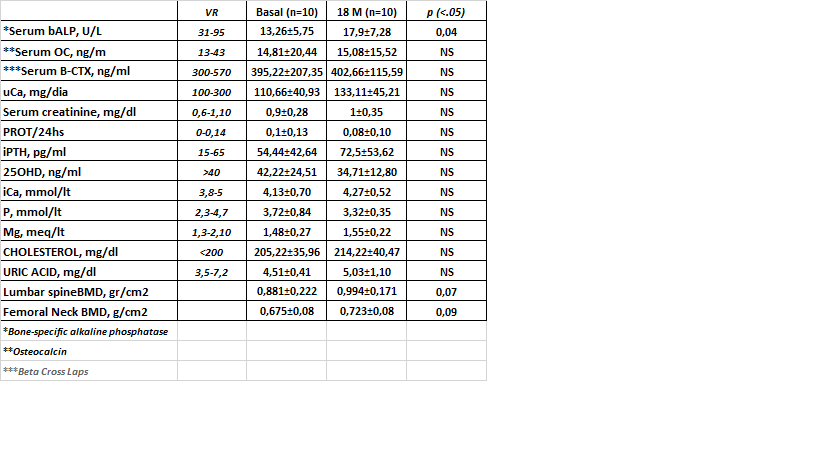Teriparatide in kidney transplant patients with bisphosphonate-resistent osteoporosis
Luis R. Leon1, Maria C. Rial1, Olga E. Guardia1, Ana Uriona1, Rosa Franzini1, Lorena Tana1, Javier Walther1.
1Kidney Tranplant, Nephrology-ITAC, Caba, Argentina
Introduction: Bisphosphonates increase Bone mineral density (BMD) by suppressing bone turnover inhibiting osteoclastic function with risk of inducing adynamic bone disease. Teriparatide is a fragment of the natural human parathyroid hormone (PTH) consisting of the first 34 amino acids counting from the N-terminus end of the natural PTH. Is anabolic drugs stimulate bone formation by increasing osteoblast activity and regulates both bone formation and resorption reducing the risk of vertebral and nonvertebral fractures.
Arm: Teriparatide (Parathormone 1-34) treatment in renal trasplant patients with bisphosphonate-resistent osteoporosis.Metods: observational describe study of cases series of 10 kidney transplant patients with bone fragility without response to prolonged treatment with bisphosphonates (greater than 3 years). They were treated with daily subcutaneous injections of 20 microg teriparatide (PTH 1-34) by 18 months. All the patients had 6 months of bisphosphonate wash out.
Measurements: we investigated bone turnover markers and effect of teriparatide over BMD of the femoral neck and lumbar spine as well also fractures, graft rejection, cardiovascular events, death and drug related adverse event.
Results: 10 patients 9 women, mean age 64.4±14.15 years, BMI 24.3 ±2.64, etiology 3GMN, 3 PKD, 3 unknown, 1 NDBT, HD 9, preempive 1, transplant Time 10.12±5.21 years, 1 preemptive, 8 DBD and 1 LRD,
Induction: 8 thymoglobulin, 2 basiliximab, Maintenance 5 belatacept/mycophenolate/MTP, 2 rapamune/mycophenolate/MTP, 3 tacrolimus/mycophenolate/MTP, 6 patients with fractures prior to treatment. Mean of treatment with bisphosphonates 4.1±1.79 years. It is observed at 18 months of treatment with 1-34 PTH increased levels of bone alkaline phosphatase (13.26 UI/L ± 5.75 vs 17.90 ± 7.28, p = 0.045), with NS changes in the rest of the analytes (Table 1) and increase of lumbar bone density of 11.27% (0.8816 gr/cm2 (TS-2.6) vs 0.9941 gr/cm2 (TS-1.38)) and femoral neck of 7.07% (0.6752 gr/cm2(TS-2.5) vs 0.7230 gr/cm2(TS-2.19)).

2 patients presented wrist fractures during treatment with low response(lumbar BMD) to treatment. No cardiovascular events, rejections, deaths were reported. Adverse Events: 1 patient presented hypotension during the first month of treatment.
Conclusion: In this group of patients, and adequate response to teriparatide treatment was observed however our limitation were small number of patients and bone biopsy prior teriparatide treatment.

right-click to download
